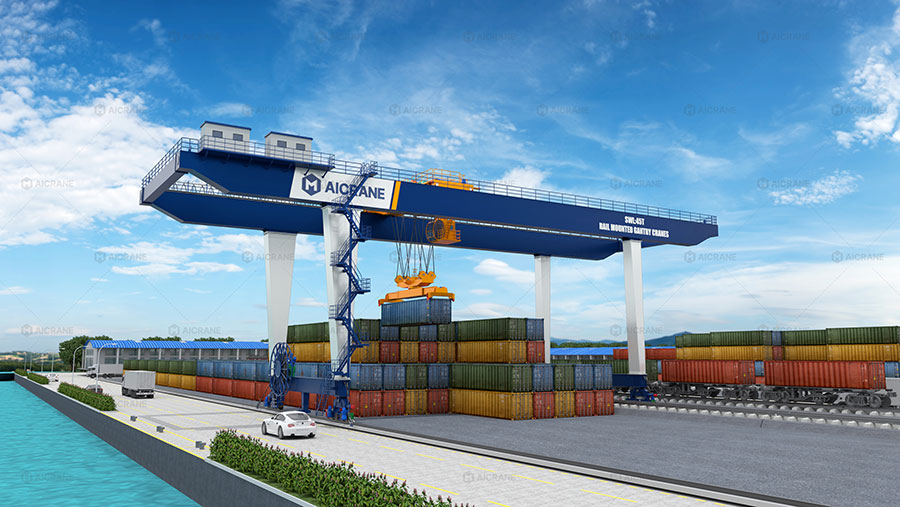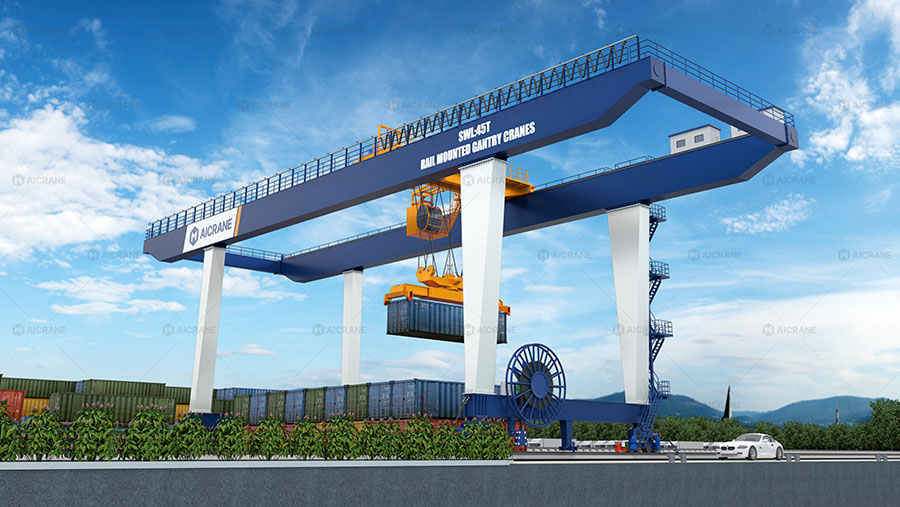Container gantry cranes are indispensable machines in modern port terminals, facilitating the rapid and efficient handling of shipping containers. Their robust design, high load capacity, and precise operation enable the swift transfer of containers between ships, trucks, and storage yards. The structural integrity and functional efficiency of these cranes heavily rely on their key components, each requiring careful engineering and design considerations to ensure safety, durability, and performance.
In this article, we explore the main structural components of container handling gantry cranes and discuss the critical factors influencing their design.

1. Overview of Container Gantry Cranes
Container gantry cranes generally consist of a large overhead bridge structure supported by two legs running on rails parallel to the quay or yard. A trolley with a hoisting mechanism moves along the bridge, lifting and lowering containers. The cranes are designed to handle containers typically sized 20-foot and 40-foot, with some specialized cranes capable of handling larger units.
2. Main Structural Components
A. Bridge Girder
The bridge girder forms the main horizontal framework spanning the distance between the crane’s legs. It supports the trolley and hoisting equipment that moves containers across the span.
-
Design Considerations:
-
Load Capacity: The girder must withstand not only the vertical load of the containers but also dynamic forces caused by trolley acceleration and wind.
-
Span Length: Longer spans increase the bending moments, requiring stronger and stiffer girders.
-
Material Selection: High-strength steel with excellent fatigue resistance is typically used to ensure long service life.
-
Weight Optimization: Minimizing weight without sacrificing strength helps reduce the load on supporting legs and foundations.
-
Vibration and Deflection Control: Excessive deflection affects container handling precision; thus, girders are designed for high stiffness.
-
Fabrication Method: Welded box girders or lattice girders are common, each offering different weight-to-strength ratios and fabrication costs.
-
B. Crane Legs
The vertical legs support the bridge girder and transfer the loads to the ground rails.
-
Design Considerations:
-
Height and Clearance: The legs must provide sufficient height for stacking containers and operating vehicles beneath the bridge.
-
Structural Strength: Legs must resist axial loads from the bridge and lateral loads from wind and crane acceleration.
-
Material and Cross-section: Steel box or lattice structures are preferred for high strength-to-weight ratio.
-
Stability: Design includes bracing and stiffeners to prevent buckling under heavy loads.
-
Foundation Interface: Legs must connect securely to rail-mounted bogies or wheels, with design accommodating thermal expansion and contraction.
-

C. Trolley and Hoist Mechanism
The trolley runs on the bridge girder, carrying the hoisting mechanism that lifts containers.
-
Design Considerations:
-
Weight Minimization: A lighter trolley reduces the load on the bridge and legs.
-
Durability: The trolley must withstand continuous movement and heavy loads.
-
Load Distribution: Proper wheel arrangement and track design prevent excessive wear.
-
Integration: The hoisting mechanism must be securely attached with considerations for load transfer and vibration damping.
-
D. Rails and Wheels
Rails on the quay or yard and wheels on the legs enable the RMG crane to move longitudinally along the working area.
-
Design Considerations:
-
Track Alignment: Precise alignment minimizes operational issues and wear.
-
Wheel Load Capacity: Wheels must support the entire crane weight plus the lifted load.
-
Rail Material: High-quality, hardened steel rails resist deformation.
-
Thermal Expansion Joints: Accommodate temperature-induced length changes without structural damage.
-
E. Operator Cabin
The operator cabin is usually mounted on the bridge or on one of the legs, providing the crane operator with a clear view.
-
Design Considerations:
-
Ergonomics: Comfort and visibility are key for operational safety and efficiency.
-
Vibration Isolation: Cabins are designed to minimize vibration transmitted from crane movement.
-
Weather Protection: Climate control and protective glazing help maintain operator comfort in all weather.
-
3. Design Considerations for Structural Components
A. Load Analysis and Structural Strength
Container gantry cranes are subjected to complex load combinations, including:
-
Dead Loads: The weight of the RMG or RTG crane components themselves.
-
Live Loads: The weight of containers during lifting and transfer.
-
Dynamic Loads: Forces generated by trolley acceleration, deceleration, and sudden stops.
-
Environmental Loads: Wind pressure, seismic forces, and temperature effects.
Design engineers use advanced load calculations and Finite Element Analysis (FEA) software to simulate stresses and deformations in various conditions. Safety factors are incorporated to ensure reliability.
B. Material Selection
Steel is the primary material due to its high strength, ductility, and availability. Modern cranes often use high-strength low-alloy steel grades to reduce weight and enhance fatigue resistance.
Material selection also considers corrosion resistance, especially in marine environments. Protective coatings, galvanization, and periodic maintenance are critical to extending the crane’s lifespan.
C. Fatigue and Durability
Repeated lifting cycles and exposure to environmental conditions cause fatigue in structural components. Designers focus on avoiding stress concentrations by using smooth welds, rounded edges, and uniform cross-sections. Regular inspections and maintenance plans are also integrated into the crane’s lifecycle management.
D. Thermal Expansion and Contraction
Large steel structures expand and contract with temperature changes. Design must include expansion joints and sliding bearings where necessary, especially in the bridge and rail interfaces, to prevent structural damage.
E. Vibration and Deflection Control
Excessive deflection reduces the precision of container placement and can cause operational hazards. The structure must be stiff enough to minimize bending and vibrations. This often involves optimizing girder cross-sections and adding bracing elements.
4. Modern Design Innovations
-
Use of Lattice Girders: Reduces wind resistance and structural weight while maintaining strength.
-
Composite Materials: Some experimental designs incorporate composite reinforcements to improve weight and corrosion resistance.
-
Automation-Friendly Structures: Designing for easier installation of sensors and automation devices.
-
Modular Construction: Prefabricated components allow faster assembly and easier replacement.
5. Conclusion
The design of container gantry cranes is a complex engineering task that requires balancing strength, durability, operational efficiency, and safety. The key structural components — bridge girder, crane legs, trolley, rails, and operator cabin — each have unique design challenges and considerations. By carefully analyzing load conditions, selecting appropriate materials, and integrating modern design techniques, engineers create port gantry cranes that meet the demanding requirements of container handling in busy ports worldwide.
Understanding these structural components and their design intricacies not only enhances the performance of the cranes but also ensures the safety of operations and extends the service life of these vital port assets.